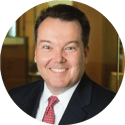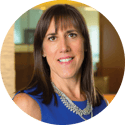|
DAN FUSS AND THE FULL DISCRETION TEAM'S SUCCESSION PLAN |
|
|
|
ELAINE STOKES This is the last stage of a succession plan we've been working on for the past 20 years. Dan is taking a significant step back from day-to-day portfolio management, but he's not retiring. He'll remain on the team as a senior advisor and will continue to share the same market insights that he has during his career. And we are going to continue to manage the portfolios in the style and tradition that we have built on for all these years. Nothing about that is going to change. |
 |
BRIAN KENNEDY March 1 marks Dan’s 45th year at Loomis Sayles and that's a remarkable accomplishment. There are topics Dan has been following for the past 60 years, including insights on government policy, geopolitical issues, military events, climate change, central bank policy, and the global flow of funds. He is passionate about these topics and we will continue to communicate frequently with Dan on them. We're very fortunate to have a resource available to us with his tenure and perspective. He’s an invaluable asset to our team and the larger organization. |
 |
MATT EAGAN A lot of people ask us when we started thinking about succession planning and it really goes back to 2000, when Elaine and I joined Dan to co-manage Full Discretion portfolios. Elaine joined from the trading desk and I came from the research group and we worked really well together; I think Dan saw a benefit to our combined skill set. That was around the same time Jae Park came on board as CIO, taking those responsibilities from Dan. He had an overarching goal of taking the investment side of Loomis Sayles to a new level and Elaine and I started working closely with him to institutionalize the “Dan Fuss” style of investing. Jae was helpful in taking what was inside of our minds and sharpening it in a way that we could document and provide proof statements for. We will continue this work with David Waldman, for whom we have a lot of respect . He’s a terrific guy. Elaine and I have worked closely with David on a number of initiatives over the years and collaborate with him as members of the management committee. He shares Jae’s passion for investment frameworks and I know he is very supportive of our team. |
|
TEAM RESOURCES |
|
 |
MATT EAGAN Twenty years after we started planning, we look at where we are and it's pretty amazing. At this point, our team consists of about 30 people dedicated to the Full Discretion platform. We have an experienced portfolio management team (Elaine, Brian, Todd Vandam and me) and are supported by six very seasoned strategists who help us within individual market segments and bottom-up security selection. Working with Jae and David, we've also developed a specialized credit research group that sits with us and conducts very intense research in addition to and in conjunction with our centralized credit research team. This is particularly important when it comes to our high-conviction credit ideas. We've also added securitized credit support with the help of Alessandro Pagani's team (Mortgage and Structured Finance) as well as bank loans and other segments. And we've invested in advanced portfolio analytical tools that permeate our process. All of this and we leverage the nearly 200 investment and research professionals in our centralized research and trading functions. This is a pretty formidable engine that continues to serve us well and helps us adapt to ever-changing markets and client demands. |
|
THE FULL DISCRETION PHILOSOPHY |
|
 |
ELAINE STOKES First, we believe markets are inefficient. They're inefficient because of fear, greed, technicals, lack of liquidity, and all of those things can drive dislocations in the market. So how can one take advantage of those dislocations? One has to be willing to be opportunistic. We take a long-term view, we do our homework and our research because research is really going to drive the ability to gain comfort in making those high-conviction investments.. The second thing is that we feel it's important to buy bonds that can go up, which sounds simple, right? But a lot of bonds get capped out by call price and by dollar price. And we think it's really important to add convexity into the portfolio where we can. We are constantly looking to buy the discount bond, the non-callable bond, the bond with the structure that will allow it to go up. We are true bond pickers, not only in that we have to get the name right, but we have to get the right instrument. We have a really broad toolbox. There are different points in the cycle and varying economic factors that signal us to start using off-benchmark sectors, whether it's emerging markets, convertible bonds, non-dollar, even equities. We will use them when we believe it's appropriate, when we believe it's a good time in the cycle, and when opportunities present themselves. |
 |
MATT EAGAN The foundation of our framework rests upon the investment philosophy that Dan Fuss established so many years ago. We have not strayed; we've all been brought up in that and it's implanted in our DNA. We have translated that into an explicit and well-documented investment framework that we believe can stand the test of time. |
|
A PHILOSOPHY THAT SPANS PRODUCTS |
|
 |
ELAINE STOKES Our philosophy resonates throughout our entire product spectrum. It's not just the products that have “full discretion” or “multisector” in their name. We rely on our process and work very hard to build repeatable strategies and frameworks that help us identify value. |
 |
MATT EAGAN This philosophy spans all Full Discretion products, which we’ve broadened over the years. We’ve complimented our longstanding Core Plus Full Discretion and Multisector Full Discretion products with our US High Yield and Global High Yield products; we are in the nontraditional unconstrained space with Strategic Alpha and Strategic Alpha Opportunistic, which just hit their 10-year anniversary in November; and we recently launched an opportunistic multisector credit mutual fund in September. |
|
MARKET OUTLOOK |
|
 |
BRIAN KENNEDY I would point to three things right now as a backdrop. Anticipation of the global economic recovery due to the vaccines is our number one. Couple that with central bank influences that have been keeping interest rates low. And then, there is optimism around further stimulus in the near term. We have seen interest rates rise modestly in recent months, but rates are lower than what most of us have seen in our careers. Right now, it’s imperative in our view that a portfolio has the flexibility to look for yield and return without being tethered to interest rates and duration. |
 |
ELAINE STOKES We are currently maintaining our credit exposure and on the margin adding to credit. And when I say credit, I'm speaking broadly. That's investment grade credit, high yield credit, emerging market credit, and even convertibles. We’re in the recovery phase as we see it and we expect spreads to tighten, especially if we get the anticipated fiscal package and a potential follow-up package next year when the new administration steps in. It's interesting to note that the downside resulting from COVID-19 has been somewhat muted. A lot of downgrades and defaults got pulled forward, but much of that is behind us. And now we can look forward with a better understanding of what the potential losses might be. The US is still sitting on some of the highest yields in the world and that carry alone is an important part of the returns over time. |
 |
MATT EAGAN The convexity of the high yield market has become more and more negative. I think it might be at an all-time negative number, which is to say that there's a lot of call risk embedded in the high yield market. We don't like negative convexity. Fortunately, through our bond-picking capabilities in areas like fallen angels, we can build in some positive convexity to our portfolios. That should be a benefit on a relative basis in terms of upside/downside potential. We are going down a bit in the capital structure to things like convertible bonds, which tend to do well in this phase of the cycle. There's no such thing as a growth bond, except in the case of convertibles to the extent they can take off if stocks take a lead in the recovery. We believe we've been finding some gems in the corporate space and global enterprises that are in emerging markets but are likely to compete on a global scale. We are looking at non-dollar, which tends to do well in global reflation. |
Disclosure
Any investment that has the possibility for profits also has the possibility of losses.
The discussion above is provided for informational purposes only and is not to be construed as investment advice. Investment decisions should consider the individual circumstances of the particular investor. Any opinions or forecasts contained herein reflect subjective judgments and assumptions of the author and do not necessarily reflect the views of Loomis, Sayles & Company, L. P. or any portfolio manager. Investment recommendations may be inconsistent with these opinions. There can be no assurance that developments will transpire as forecasted. Data and analysis does not represent the actual or expected future performance of any investment strategy, account or individual positions. Accuracy of data is not guaranteed but represents our best judgment and can be derived from a variety of sources. Market conditions are extremely fluid and change frequently. Opinions are subject to change at any time without notice.
Commodities, interest and derivative trading involves substantial risk of loss.
There is no guarantee that investment objective will be realized or that the strategy will generate positive or excess return.
Past performance is no guarantee of, and not necessarily indicative of, future results.
LS Loomis | Sayles is a trademark of Loomis, Sayles & Company, L.P. registered in the US Patent and Trademark Office.
MALR026518
Loomis, Sayles & Company, L.P. | One Financial Center, Boston, MA 02111 | 800.343.2029
Sitemap | Privacy Policy | Cookie Policy | Important Information